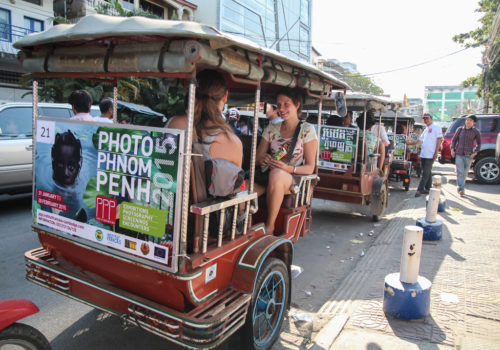There’s an immense installation by Corinne Vionnet on the wall of the French embassy. It’s hot out and the panels, three meters tall, are placed haphazardly against the wall. The text is lost between the Eiffel Tower and the Golden Gate Bridge, not far from Stonehenge and the Tower of Pisa. A young man parks his motorbike and, holding up his smartphone, politely asks permission to take a picture. He looks over the text before hopping back on his bike and disappearing into traffic. He had been struck by the photos, surprised perhaps by the unusual and pictorial appearance of the monuments, some of which he might have recognized—Angkor Wat, created by the artist specifically for the festival—but he didn’t know what it was about. He photographed the text, and learned that the images are made up of a hundred images found on the internet, the “ordinary” perspectives that tourists send to their friends and family.
That’s also what Photo Phnom Penh is about: presenting images in a public space accompanied by short texts to help viewers understand them. And that’s essential in a country where there’s no instruction in photography or how to approach images.
The set of pictures, at the French Institute of Cambodia, forty years after the rise of Pol Pol, offers three different aesthetics examining the relationship between memory, History and photography, leading to questions from the local students in French classes who pass by it every day. They have questions for the photographers while the pictures are being hung up, and they learn by touching the prints during breaks between classes. They are the same questions that Nissa, 15, asks her father, Mak Remissa, who was 7 in 1975, and who has now reconstructed, using strips of paper, the evacuations from the city which he underwent with his family, the Khmer Rouge having emptied out all urban centers.
What’s impressive this year is the existence of a Cambodian Association that now organizes the festival. There are many volunteers: students, young photographers, people with real skills in communications, graphic design, organization. A group formed, divided up the tasks, and runs the Facebook page which attracts new followers every day, taking part in the installations, getting friends involved, hanging up posters, running errands, brainstorming. Clearly, the future of the PPP, although it will still require funding, has been taken up by the Cambodians, who know what they want, and who have given new life to the project.
Despite the difficulties of the process, there’s a sense of accomplishment, made possible by the employees of the French Institute who have been involved with the festival for a long time. And the weather was perfect for visitors out to see the photographs on Sisovath dock by the river. All is well.
FESTIVAL
Photo Phnom Penh 2015
From January 31th to February 28th, 2015
Institut français du Cambodge
218 rue 184 – Phnom Penh
Cambodia
+855 (0)23 213 124 / 125
[email protected]
www.institutfrancais-cambodge.com
















